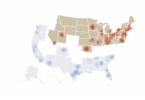short list
Between the Boxes

Every good agent knows the age-old adage ”location, location, location,” but lately there have been some interesting twists on what that means. Data shows that amenities such as a Starbucks going into a neighborhood can have a positive impact on home values. What about some other popular retailers, like the ubiquitous big-box chains, Target and Walmart?
RealtyTrac recently released compelling data on how proximity to either a Target or Walmart impacts property values. It turns out that while living near a Target may be a drain on your wallet, it could be a boost to your home’s value. Homes located near the store saw greater price appreciation than the national average.
Those living near Walmart also saw an increase in value, but their homes appreciated at a lower rate than the national average.
Among homeowners who sold in 2015, those living in the same ZIP code as a Target saw an average 27 percent increase in home prices since they purchased their home, or an average price gain of $65,569. Thats about 5 percent higher and nearly $25,000 more than the national average, which is 22 percent, or about $40,626.
Meanwhile, those homeowners who live in the same ZIP code as a Walmart only saw a 16 percent price gain, or $24,900, falling short of the nations average.
Though the data seems to favor Target, there is a drawback: Living near a Target also means higher property taxes. Homeowners near Target paid an average of $7,001 in property taxes each year while those living near a Walmart paid just $3,146. Compare that to the national average of $4,283.
Homes near a Target are also more expensive, averaging $307,286, while homes near Walmart average $178,249.
When taking clients out to shop for homes, REALTORS® can boast that not only is living near a Target convenient, it may actually mean better price appreciation down the road—as long as you have the budget for it.







